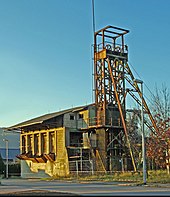Melsbach clay pit
The Melsbach clay pit is a former clay and alum mine near the village of Melsbach in the Neuwied district . It was once the oldest alum mine in Rhineland-Palatinate .
location
The former clay pit Melsbach was located on the site of today's Kreuzkirch district , near the southern entrance to the town. There was an access (the main entrance), where today the Grade II listed headframe are besides work hut and coil stock. A second entrance was near the current ruins of the Kreuzkirche . Opposite the ruins, on the left side of the entrance to the village, there is a huge spoil dump that was flattened in the 1960s and is now used as a football field .
history
The clay deposits were discovered in 1786 when the wealthy factory owner and entrepreneur Heinrich Wilhelm Remy needed coal for his steel and rolling mill " Rasselstein " in the Wiedtal near Neuwied. At first only lignite was found , but then abundant deposits of sulfuric acid white clay and colored clay. The camps were at a depth of about 90 meters. High levels of siderite and alum were found in these clay deposits . The Fürstlich-Wiedische forest and mountain ridge Engelhard had the oldest alum plant in Rhineland-Palatinate built in 1789 . In 1860 there was an accident in which the worker Joseph Barbanus fell leg first into an alum kettle. The alum plant was shut down around 1880 and demolished in 1882. The Melsbach clay, however, was until 1959 under the direction and supervision of Dr. C. Otto & Comp. further degraded. Today the iron are only headframe besides work hut and the associated reel support received. The headframe can be viewed at any time, but climbing is prohibited because of the risk of collapse due to rust .
meaning
The clay deposits with their rather small size were not of great regional importance. Nevertheless, the Melsbach clay was highly valued thanks to its fire resistance. Above all, the high content of natural siderite and alum caused the demand to rise again regularly. However, the clay pit did not bring any financial gains to the village community of Melsbach.
literature
- Albert Hardt: Melsbach and its history . In: In the Wiedisches Land: History of the places in the Verbandsgemeinde Rengsdorf . Verbandsgemeinde Rengsdorf, 1989, OLCL -Nr .: 180399097.
- Ralf Schaumann: Technology and technical progress in the industrialization process: shown. using the example of d. Paper, sugar and chem. Industry d. northern Rhineland (= Rheinisches Archiv , Volume 101). Röhrscheidt Verlag, Bonn 1977, ISBN 3792803909 , pp. 233 & 403.
- R. Herrmann: Where is clay extracted? In: Keramische Zeitschrift , 41st edition, 2nd half of 1989. Erich Schmidt Verlag, Bielefeld 1989, p. 85.
- Joachim Kermann: The Manufactories in the Rhineland 1750-1833, Edition 82 (= Rheinisches Archiv , Vol. 82). L. Röhrscheid, Bonn 1972, ISBN 9783792803196
- HE von der Heydt: Accidents at the mine in Prussia in 1860 . In: Journal for the mining, metallurgy and saltworks in the German Empire , Volume 9. Verlag Ernst & Sohn, Hürth 1861, page 21.
Individual evidence
- ↑ Joachim Kermann: The factories in the Rhineland 1750-1833, Issue 82 . Page 438.
- ↑ R. Herrmann: Where is clay extracted? Page 85.
Coordinates: 50 ° 29 ′ 0.6 ″ N , 7 ° 28 ′ 56.4 ″ E

